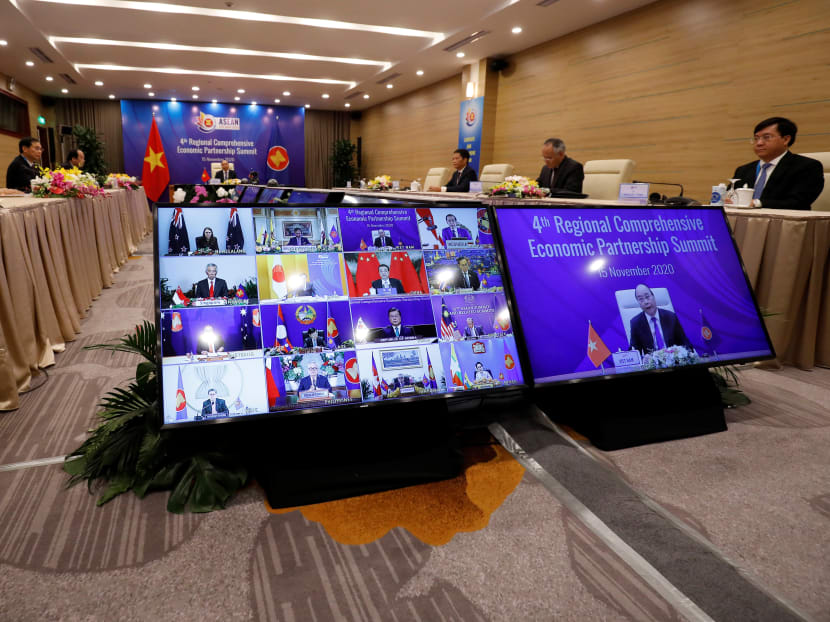Explainer: What is the RCEP trade deal and how will it benefit Singapore?
SINGAPORE — Fifteen Asia-Pacific countries signed the world’s largest free trade deal on Sunday (Nov 15), seen as a move that will boost the region’s economic prospects as the Covid-19 pandemic rages on around the globe.

Vietnam's Prime Minister Nguyen Xuan Phuc chairing the 4th Regional Comprehensive Economic Partnership Summit as part of the 37th Asean Summit in Hanoi, Vietnam, on Nov 15, 2020.
- The Regional Comprehensive Economic Partnership involves 15 countries in the Asia-Pacific region
- It took eight years to be finalised as members could not agree about key terms, including the movement of labour
- Economists said that Singapore will not feel the full benefits yet as the RCEP has not come into effect
- Once it does, Singapore can enjoy stronger investments and Singaporeans could see more jobs and income flow in, they added
SINGAPORE — Fifteen Asia-Pacific countries signed the world’s largest free trade deal on Sunday (Nov 15), seen as a move that will boost the region’s economic prospects as the Covid-19 pandemic rages on around the globe.
The Regional Comprehensive Economic Partnership (RCEP) was finalised after eight years of negotiations.
The participating countries are the 10 members of the Association of Southeast Asian Nations (Asean) — Singapore, Malaysia, Indonesia, the Philippines, Brunei, Vietnam, Laos, Cambodia, Thailand and Myanmar — as well as China, Japan, South Korea, Australia and New Zealand.
WHAT IS THE RCEP?
The pact consolidates smaller existing agreements, covering about a third of the global population — 2.1 billion people — and about 30 per cent of its global gross domestic product (GDP).
It is the world’s largest free trade agreement in terms of GDP.
The agreement will aim to lower tariffs, open up trade in goods and services, and promote investment to help emerging economies catch up with the rest of the world.
It will also give the participating countries preferential access into growing markets in the region, and reduce costs and time for companies by allowing them to export products anywhere within the bloc without meeting separate requirements for each country.
Rules on e-commerce, intellectual property and competition policy rights have also been established under the RCEP.
WHY IS IT SIGNIFICANT?
Among the key benefits are a tariff elimination of at least 92 per cent of goods traded, with more preferential market access for Singapore’s exports, the Ministry of Trade of Industry said.
There will also be simplified customs procedure and improved trade facilitation, lowering transaction time and costs, and giving Singapore exporters greater certainty.
The RCEP has not been ratified yet, though Singapore’s Minister for Trade and Industry Chan Chun Sing said it will happen within the next 12 months with “no firm timeline” yet.
The signing of the RCEP means that China, which has tussled with the US for economic superiority in the region, now has greater influence in the rules of trade here.
When the countries started negotiating the RCEP, talks for another major trading agreement — the “mega-regional” Trans-Pacific Partnership (TPP) led by the US — were underway. China was not among its 12 members then.
In 2017, President Donald Trump withdrew the US from the TPP, a move seen to improve the chances of success for the RCEP.
The TPP was then renamed the Comprehensive and Progressive Agreement for Trans-Pacific Partnership (CPTPP) and it includes seven RCEP members.
The RCEP's market size is nearly five times greater than that of the CPTPP, with almost double its annual trade value and combined GDP.
However, the CPTPP is seen as more comprehensive than the RCEP, which also does not include provisions on labour and environmental standards.
WHY DID IT TAKE SO LONG?
Negotiations were formally launched in 2012 at the Asean summit in Cambodia.
India was meant to be part of RCEP but pulled out last year over concerns that RCEP would hurt domestic producers, including cheap Chinese products entering the market. It can join again at any point.
Talks dragged on as member countries could not agree on key terms such as the movement of labour, treatment of services and market access.
In 2018, Chinese premier Li Keqiang said in a speech in Singapore that free trade was facing difficulties “with the headwind of trade protectionism”, the Business Times reported.
At the second RCEP summit that year, Singapore’s Prime Minister Lee Hsien Loong said that the countries had been dealing with the unique challenges of negotiating a mega free trade agreement.
“Complexities are expected as we are a group of diverse economies. For a number of us, this will be our first free trade agreement with each other,” he added.
Talks were expected to conclude last year but India then pulled out.
HOW DOES IT BENEFIT SINGAPORE NOW?
Mr Chan said on Sunday that the RCEP will be “the bright spot that points the direction ahead” during the Covid-19 pandemic.
Consumers can expect more competitive options when buying products, while businesses will have greater protection in terms of intellectual property as well as save on costs and time, he added.
Economists whom TODAY spoke to cautioned that it will take time for Singapore to enjoy the full benefits of the RCEP, as the agreement has not come into effect yet.
CIMB private banking economist Song Seng Wun said that once trade in goods and services has picked up, there could be “spillover into jobs and income for consumers”.
Given that Singapore already has trade agreements with each of the other 14 countries, there will be “less direct benefits at this point”. However, Singapore can enjoy the spillover effects of a stronger Asean bloc in the long run, Mr Song added.
“Once we get through the pandemic, the benefits of the agreement will be more apparent,” he noted.
Mr Irvin Seah, senior economist at DBS Bank, said that there have been signs of reshuffling in regional supply chains after two years of the China-US trade war and the Covid-19 pandemic.
With further integration of regional economies under RCEP, global companies and investors will find it more compelling to invest not just in China but also in Singapore, Mr Seah said.
“Singapore is a very strategic regional hub. If (companies and investors) are in for the long haul, they definitely need a location to position their key business activities. Singapore will definitely be featured quite prominently in this regard,” he added.
Mr Seah pointed out that not many regional hubs allow for global connectivity, regulatory certainty and a business-friendly environment.
Nevertheless, he warned that any immediate economic gains will not be direct and will likely come in the form of said stronger investments.
Ms Selena Ling, head of treasury research and strategy at OCBC Bank, said: “Singapore is looking ahead and pushing in with reducing barriers to allow for a freer movement of trade and investments in anticipation of a post-Covid-19 recovery.”








